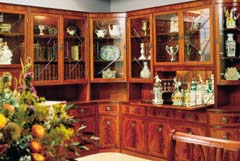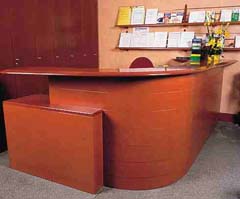Furniture
1. Wood veneered, moulded edge panels
Decorative wood veneers have been used to enhance the appearance of furniture for centuries. The smooth and close textured surface of MDF is an ideal substrate for surfacing with standard wood veneers using modern pressing technology and for the effective display of the craft of veneering using exotic veneers, cross banding and white line inlays.
Additionally, the uniform and close textured distribution of fibres throughout the thickness of MDF allows for direct profiling of the edges of wood veneered panels. This feature is being used to good effect by many traditional and reproduction furniture manufacturers.
Increasing quantities of veneered MDF are being used for table tops, doors and drawer fronts and other moulded edge panels as an alternative to more expensive and often environmentally more damaging solid wood equivalents.
Considerable cost savings can be achieved by using direct profiled veneered MDF panels instead of solid wood lipped and veneered MDF or particleboard panels. Apart from the elimination of solid wood lippings and the associated lipping joint showthrough problems, the time required for machining and bonding lippings and sanding the lipped panels is saved.
a. Panels with moulded lippings
- Cut MDF or particleboard to size
- Machine lippings
- Bond lippings
- Sand panel to level lippings and core board
- Bond wood veneers
- Sand veneered surfaces
- Mould edges
b. Direct moulded panels:
- Cut MDF to size
- Bond wood veneers
- Sand veneered surfaces
- Mould edges
The moulded edges on the MDF panels can easily be finished by scaling, staining and lacquering to match the appearance of the finished veneered surfaces. Alternatively heat transfer foils can be used to achieve a grain effect around the edges of the veneered panels.














